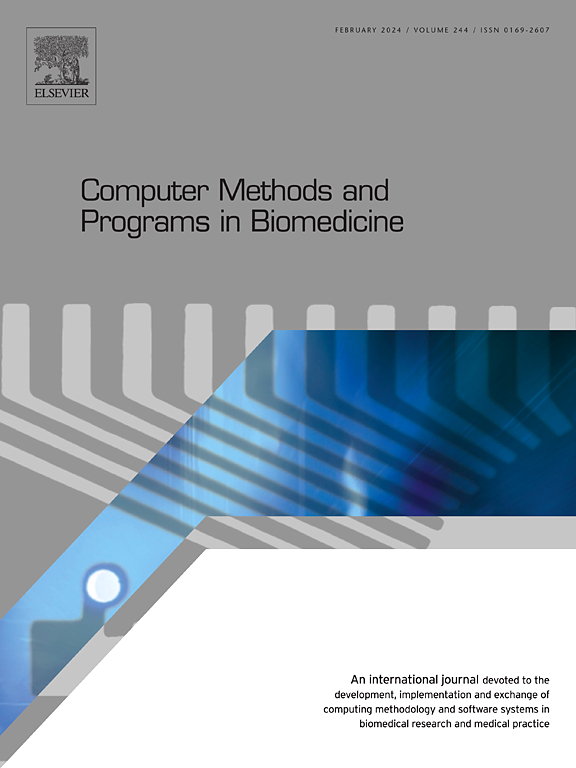Multi-region nomogram for predicting central lymph node metastasis in papillary thyroid carcinoma using multimodal imaging: A multicenter study
IF 4.9
2区 医学
Q1 COMPUTER SCIENCE, INTERDISCIPLINARY APPLICATIONS
引用次数: 0
Abstract
Background and objective
Central lymph node metastasis (CLNM) is associated with high recurrence rate and low survival in patients with papillary thyroid carcinoma (PTC). However, there is no satisfactory model to predict CLNM in PTC. This study aimed to integrate PTC deep learning feature based on ultrasound (US) images, fat radiomics features based on computed tomography (CT) images and clinical characteristics to construct a multimodal and multi-region nomogram (MMRN) for predicting the CLNM in PTC.
Methods
We enrolled 661 patients diagnosed with PTC by thyroidectomy from two independent centers. Patients were divided into the primary cohort, internal test cohort (ITC), and external test cohort (ETC), and collected their US images and CT images. Resnet50 was employed to predict the CLNM status of PTC based on US images. Using radiomics feature extraction methods to extract fat radiomics features from CT images. Feature selection was conducted using the least absolute shrinkage and selection operator (LASSO) regression. The predictive performance of the MMRN was evaluated using five-fold cross-validation. We comprehensively evaluated the DLRCN and compared it with five radiologists.
Results
In the ITC and ETC, the area under the curves (AUCs) of MMRN were 0.829 (95 % CI: 0.822, 0.835) and 0.818 (95 % CI: 0.808, 0.828). The calibration curve revealed good predictive accuracy between the actual probability and predicted probability (P > 0.05). Decision curve analysis showed that the MMRN was clinically useful. Under equal specificity or sensitivity, the performance of MMRN increased by 6.5 % or 2.9 % compared to radiologist assessments. The incorporation of fat radiomics features led to significant net reclassification improvement (NRI) and integrated discrimination improvement (IDI) (NRI=0.174, P < 0.05, IDI=0.035, P < 0.05).
Conclusion
The MMRN demonstrated good performance in predicting the CLNM status of PTC, which was comparable to radiologist assessments. The fat radiomics features exhibited supplementary value for predicting CLNM in PTC.
应用多模态影像预测甲状腺乳头状癌中央淋巴结转移的多区域图:一项多中心研究。
背景与目的:中央淋巴结转移(CLNM)与甲状腺乳头状癌(PTC)患者的高复发率和低生存率相关。然而,目前还没有令人满意的模型来预测PTC的CLNM。本研究旨在整合基于超声(US)图像的PTC深度学习特征、基于计算机断层扫描(CT)图像的脂肪放射组学特征和临床特征,构建预测PTC CLNM的多模态多区域nomogram (MMRN)。方法:我们从两个独立的中心纳入661例经甲状腺切除术诊断为PTC的患者。将患者分为初级队列、内部测试队列(ITC)和外部测试队列(ETC),收集患者的超声图像和CT图像。采用Resnet50基于US图像预测PTC的CLNM状态。利用放射组学特征提取方法从CT图像中提取脂肪放射组学特征。使用最小绝对收缩和选择算子(LASSO)回归进行特征选择。MMRN的预测性能采用五重交叉验证进行评估。我们对DLRCN进行了综合评价,并与5位放射科医生进行了比较。结果:在ITC和ETC中,MMRN曲线下面积(auc)分别为0.829 (95% CI: 0.822, 0.835)和0.818 (95% CI: 0.808, 0.828)。校正曲线显示实际概率与预测概率之间具有较好的预测精度(P < 0.05)。决策曲线分析表明MMRN在临床上是有用的。在相同的特异性或敏感性下,与放射科医生的评估相比,MMRN的表现提高了6.5%或2.9%。纳入脂肪放射组学特征后,净重分类改善(NRI)和综合识别改善(IDI)显著(NRI=0.174, P < 0.05, IDI=0.035, P < 0.05)。结论:MMRN在预测PTC的CLNM状态方面表现良好,与放射科医生的评估相当。脂肪放射组学特征对预测PTC的CLNM具有补充价值。
本文章由计算机程序翻译,如有差异,请以英文原文为准。
求助全文
约1分钟内获得全文
求助全文
来源期刊

Computer methods and programs in biomedicine
工程技术-工程:生物医学
CiteScore
12.30
自引率
6.60%
发文量
601
审稿时长
135 days
期刊介绍:
To encourage the development of formal computing methods, and their application in biomedical research and medical practice, by illustration of fundamental principles in biomedical informatics research; to stimulate basic research into application software design; to report the state of research of biomedical information processing projects; to report new computer methodologies applied in biomedical areas; the eventual distribution of demonstrable software to avoid duplication of effort; to provide a forum for discussion and improvement of existing software; to optimize contact between national organizations and regional user groups by promoting an international exchange of information on formal methods, standards and software in biomedicine.
Computer Methods and Programs in Biomedicine covers computing methodology and software systems derived from computing science for implementation in all aspects of biomedical research and medical practice. It is designed to serve: biochemists; biologists; geneticists; immunologists; neuroscientists; pharmacologists; toxicologists; clinicians; epidemiologists; psychiatrists; psychologists; cardiologists; chemists; (radio)physicists; computer scientists; programmers and systems analysts; biomedical, clinical, electrical and other engineers; teachers of medical informatics and users of educational software.
 求助内容:
求助内容: 应助结果提醒方式:
应助结果提醒方式:


